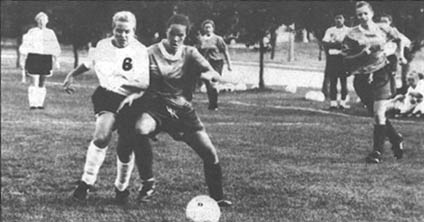![]()

Women's soccer team in action, undated.
Starting in 1986, women's soccer at UW Oshkosh was established as a club sport. It was started and organized by many women who had no previous soccer skills. The coaches were volunteer college students and women who had played soccer at the high-school level. They taught the players who had no experience. There were no official recruits, so they recruited athletes of other sports in their off-season. During the club years, UWO's team played against other participating colleges but the total number of games in a season was approximately 10. Since soccer was a club sport, there was little documentation of competition, travel, players, or the season.
In the fall of 1993, the women started sharing the fields with the men. Bruce Coleman was the first Varsity women's soccer coach and had little experience coaching soccer, but he took it on as a challenge. He stated in the October 7th issue of the Advance Titan that Toby Bares, the men's soccer coach at UWO, helped him out by being a great resource. There was no time to recruit for the first year of intercollegiate soccer because the team was not official until June of 1993. Coach Coleman made do with whom he had and started recruiting for the 1994 season. This was the first time that women's soccer had competed as an official intercollegiate sport in the Wisconsin Women's Intercollegiate Athletic Conference (WWIAC). Al Ackerman, the athletic director at UWO, commented in the Advance Titan (Oct. 7, 1993), "The possibility of a women's soccer team competition at an intercollegiate level was discussed for many years, buy they could not get the additional funds they need from allocations." Once the funding went through, Oshkosh along with Superior, added a women's team in 1993. In 1994, River Falls and Stout also added teams. At this point, there were seven women's soccer teams in the WWIAC.
Women's soccer is the second most recent sport to become varsity here at Oshkosh, followed by golf. Only one year after the women's team completed its first season, a JV team was proposed for Oshkosh. The plan proposed on August 18, 1994 in the Gender Equity CQI Team Report was to "develop the Gender Equity CQI team to work on the goal of achieving athletic proportionality under the rules of the Title IX" (pg. 2). At this time, UW Oshkosh was not in compliance with Title IX. There was an enrollment consisting of 57% female and 43% male students at the university in contrast to 64% male and 36% female students participating in athletics (pg.2). In order to even out the numbers, the plan highlighted for women's sports included the following:
-
Add new varsity sports of golf (or bowling) and lacrosse (or other team sports).
-
Add new JV sports for swimming, softball, and soccer.
-
Increase squad size.
From 1995 to the present, David Farin has been the head coach for the women's team. The season consists of close to 20 games. Each team in the conference plays each other once in the season. A round robin tournament then follows for seats at the conference play-offs. The makeup of the season's play has not changed considerably throughout the years. The only difference has been the number of teams that are included in the conference.
Burman, M. (1999, October, 7). Advanced Titan. p. 12.
Coleman, Bruce. (1999). Personal interview on the history of women's soccer at The University of Wisconsin Oshkosh.
Farin, David. (1999). Personal interview on the history of women's soccer at The University of Wisconsin Oshkosh.
Gender Equity CQI Team Report. (1994, August, 18). Wisconsin document.
Ludvik (Milbauer), Christine. (1999). Personal interview on the history of women's soccer at the University of Wisconsin Oshkosh.
